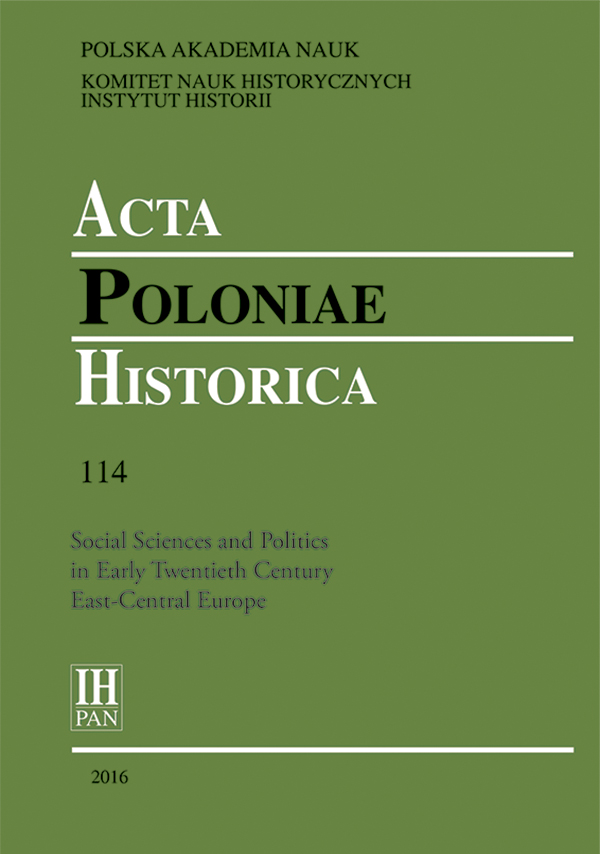Dark Agents of Sex: Searching for the Sources of Prostitution in Early Twentieth Century Poland
DOI:
https://doi.org/10.12775/APH.2016.114.04Keywords
prostitution, nature versus nurture debate, social hygiene, eugenics, traffic in women and children, anti-Semitism, PolandAbstract
A rise of interest in issues of heredity and advances in medicine in the nineteenth century resulted in the widespread medicalization of social phenomena. Theories formulated in the field of natural sciences increasingly served as a tool to explain unacceptable patterns of social behaviour, including prostitution which began to be seen as a biologically determined condition. As a main channel for the spread of STDs – some of them potentially transmissible across generations (congenital syphilis) – prostitution became one of the major concerns of medical professionals. Thus, what was previously a sin and an insult to middle-class moral standards, now came to be seen as a health menace to the entire population. In times of increased competition between nation-states, the latter argument played an even more important role, and the ruling elites sought to tighten control over what they perceived as ‘dangerous bodies’. As campaigners against the ‘great social evil’ also analysed prostitutes’ social milieu, discourses on the causes of prostitution were highly confusing. One source of confusion was Morel’s theory of degeneration, in which the author skilfully combined environmental influence with the concept of hereditary pathology. Additionally, some authors still adhered to a much older explanation for social ills. The construction of an evil ‘Other’ – typically unscrupulous Jew – responsible for planting various physical and/or moral ‘plagues’ in a victimized population, thus threatening its biological existence. The fear of deterioration, inevitably leading to extinction, unified proponents of old-style and modernist anti-vice campaigners. This article offers an overview of expert narratives on the causes of prostitution in the early decades of twentieth century Poland.References
Baldwin Peter, Contagion and the State in Europe 1830–1930 (Cambridge, 1999).
Bernstein Laurie, Sonia’s Daughters: Prostitutes and their Regulation in Imperial Russia (Berkeley, 1995).
Blobaum Robert (ed.), Antisemitism and its Opponents in modern Poland (New York, 2005).
Bristow Edward, Prostitution and Prejudice. The Jewish Fight against White Slavery 1870–1939 (Oxford, 1982).
Daszyńska-Golińska Zofia, Zagadnienia polityki populacyjnej (Warszawa, 1927). Glensk Urszula, Historia słabych. Reportaż i życie w dwudziestoleciu (1918–1939) (Kraków, 2014).
Goode Erich and Nachman Ben-Yehuda, Moral panics. The social construction of deviance (Malden, 1994).
Grzywo-Dąbrowska Maria, Psychologia prostytutki (Warszawa, 1928).
Guy Donna J., Sex and Danger in Buenos Aires. Prostitution, Family and Nation in Argentina (Lincoln and London, 1991).
Horn David G., The Criminal Body. Lombroso and the Anatomy of Deviance (New York and London, 2003).
Jedlicki Jerzy, Świat zwyrodniały. Lęki i wyroki krytyków nowoczesności (Warszawa, 2000).
Kamiński Jan Maurycy, O prostytucji (Warszawa, 1875).
Koreywo Bolesław, Dwie moralności a walka z nierządem (Poznań, 1925).
Lipska-Toumi Marzena, Prawo polskie wobec prostytucji w latach 1918–1939 (Lublin 2014).
Maćko Józef, Nierząd jako choroba społeczna (Warszawa, 1938).
Maćko Józef, Prostytucja. Nierząd – handel żywym towarem – pornografia ze stanowiska historii, etyki, higieny i prawa (Warszawa, 1927).
Mahood Linda, The Magdalene. Prostitution in the 19th century (London and New York, 1990).
Michlic Joanna B., Poland’s Threatening Other, The Image of the Jew from 1880 to the Present (Lincoln and London, 2006).
Paleolog Stanisława, The Women Police of Poland 1925–1939 (London, 1957).
Peiss Kathy and Simpson Christina (eds.), Passion and Power. Sexuality in History (Philadelphia, 1989).
Płonka-Syroka Bożena (ed.), Oczekiwania kobiet i wobec kobiet. Stereotypy i wzorce kobiecości w kulturze europejskiej i amerykańskiej (Kultura i emocje, Warszawa, 2007).
Popowicz Kamil, Lamarkizm społeczny a rasizm i eugenika we Francji (Warszawa, 2009). Rodak Mateusz, ‘Prostytutki żydowskie w województwie lubelskim w dwudziestoleciu międzywojennym. Analiza środowiska’, Kwartalnik Historii Żydów, 3 (2006), 379–90.
Sikorska-Kulesza Jolanta, Zło tolerowane. Prostytucja w Królestwie Polskim w XIX w. (Warszawa, 2004).
Spongberg Mary, Feminizing Venereal Disease. The Body of the Prostitute in Nineteenthcentury Medical Discourse (New York, 1997).
Stauter-Halsted Keely, ‘Moral Panic and the Prostitute in Partitioned Poland: Middle Class Respectability in Defense of the Modern Nation’, Slavic Review, lxviii, 3 (2009), 557–81.
Stauter-Halsted Keely, ‘The Physician and the Fallen Woman: Medicalizing Prostitution in the Polish Lands’, Journal of the History of Sexuality, xx, 2 (2011), 271–90.
Turda Marius (ed.), The History of European Eugenics, 1900–1945. Sources and Commentaries (London and New York, 2015).
Uzarczyk Kamila, ‘“Sonjas Töchter”: Die Darstellung der Prostitution in der polnischen Literatur des 19. und 20. Jahrhunderts’, Historie. Jahrbuch des Zentrums für Historische Forschung der Polnischen Akademie der Wissenschaften, iii (2009/10), 166–81.
Zalewski Władysław, Z dziejów prostytucji w Warszawie (Warszawa, 1923).
Żarnowska Anna and Szwarc Andrzej (eds.), Kobieta i rewolucja obyczajowa. Społeczno-kulturowe aspekty seksualności. Wiek XIX i XX (Warszawa, 2006).
Downloads
Published
How to Cite
Issue
Section
License
Title, logo and layout of journal are reserved trademarks of APH.Stats
Number of views and downloads: 700
Number of citations: 2



